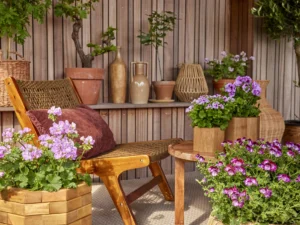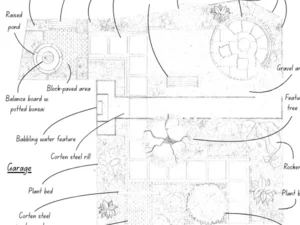Introduction
As the effects of climate change intensify and public awareness around environmental health grows, landscaping is increasingly recognised not just as an aesthetic improvement but as a vital tool in combating pollution, enhancing biodiversity, and promoting sustainability.
Thoughtfully designed outdoor spaces, gardens, parks, hedges, and trees can do a lot more than just look pretty. They can filter the air, reduce noise, manage water, and support wildlife, making them powerful allies in the fight for a healthier environment.
In this article, we’ll explore what pollution really means, what the main sources are in Norfolk, and how landscaping practices can help mitigate these. We’ll also suggest five landscaping strategies, explain them in detail, and look at other supporting ideas to fully realise the potential of green spaces.
Forms of Pollution
Pollution is anything that introduces harmful substances or disturbances into the environment, with damaging effects. It comes in several forms:
Air Pollution
This includes gases like nitrogen dioxide, sulphur dioxide, ammonia, volatile organic compounds and particulates that can penetrate the lungs. These originate from combustion, agricultural operations, and more.
Water Pollution
Contamination of rivers, streams, dykes and broads from agricultural runoff, industrial effluents, sewage overflows or leaks.
Noise Pollution
From traffic, industrial operations, loud neighbours, construction, and excess sound that is disruptive or harmful to health and wellbeing.
Light Pollution
Excessive or misdirected outdoor lighting, streetlights, and security lighting can disturb wildlife, animal behaviour (especially in nocturnal species), and even human sleep patterns.
Soil Pollution
Contamination from chemicals, heavy metals, overuse of pesticides, or improper waste disposal, which degrade soil quality and harm plant, microbial, and animal life.
It is important to understand the different categories to help in planning which landscaping solutions are needed, because each type may require different strategies. It is important to have a plan of action, but first, you need to know the facts.
Pollution in Norfolk
Norfolk has many strengths: wide open spaces, relatively low population density compared to big cities, and quite a lot of green and blue space. But it still faces pollution challenges. Here are some of the main pollutants and their sources in Norfolk, with some statistics to provide context.
According to the Norfolk County Council, the biggest air pollutants in Norfolk are Nitrogen Dioxide, caused by vehicles, Sulphur Dioxide, caused by the burning of coal and other combustibles, Ammonia, which is used and produced by agricultural practices such as and particulate matter, from exhaust fumes, brake and tyre wear and smoke.
Air quality is generally good in Norfolk, but there are Air Quality Management Areas in places like Norwich, King’s Lynn, and Swaffham where levels of Nitrogen exceed Government guidelines.
Agriculture features heavily in pollution concerns. For example, industrial-scale livestock farms in East Anglia (including Norfolk) have breached environmental regulations hundreds of times over recent years. These include violations causing water, ground and air pollution.
Water pollution is also an issue: in December 2024, Anglian Water was fined nearly £300,000 for sewage discharged into a watercourse feeding into the Broads Special Area of Conservation.
These statistics show that Norfolk’s pollution issues are multifaceted: transport, agriculture, domestic burning, sewage and waste management all contribute.
Landscaping Strategies to Combat Different Types of Pollution
Here are five landscaping-based ways to mitigate the kinds of pollution Norfolk faces:
- Planting Dense Trees and Hedgerows
- Living walls, vertical gardens and green screens
- Water management landscaping
- Noise barriers
- Selecting plants that absorb or filter air pollutants & store carbon
1. Planting Dense Trees and Hedgerows
Trees and hedgerows are living barriers composed of closely planted shrubs or trees. Dense evergreens or semi-evergreens retain foliage year-round, while deciduous species provide seasonal coverage when in leaf.
Often, hedgerows incorporate a mix of species at different heights to create a layered structure, enhancing their effectiveness in filtering pollutants and supporting biodiversity.
When planting dense trees and hedgerows, select species suited to Norfolk’s climate and soil, such as broadleaf evergreens like holly, yew, or laurel, which are particularly effective at filtering gases and particulates.
Position them along property edges, roadsides, or areas with high exposure to traffic or agricultural pollution, and use staggered planting with a mix of heights, tall trees at the back and shrubs in front, to create layered protection. Regular maintenance, including pruning and trimming, ensures hedges remain thick and continuous, as gaps can reduce their effectiveness.
Planting dense trees and hedgerows offers a range of environmental benefits. Their leaves trap airborne particulates and can filter gases such as NO₂, while their shade helps reduce heat and contributes to a cooling effect that can lower ozone formation. These plantings also enhance biodiversity by providing habitats for wildlife and contribute to climate mitigation through long-term carbon sequestration.
2. Living Walls, Green Screens and Vertical Gardens
Living walls and green screens are structures mounted on walls or fences, or freestanding, that support climbing or wall-grazing plants such as ivy, clematis, climbing roses, or other vigorous climbers.
Modular planting systems can also be used, allowing soil, plants, and moisture to be retained effectively, creating a vertical garden that maximises green space while providing environmental benefits.
When installing living walls or green screens, use sturdy supports or trellises attached to walls, fences, or freestanding frames. Select climbers and plants suited to your microclimate, and mix species to provide texture and year-round coverage.
For areas with limited ground space, modular green wall panels can be a practical solution, while ensuring proper irrigation, drainage, and access for maintenance will help the plants thrive.
Living walls and green screens offer multiple benefits for both the environment and the home. Their leaves help filter air pollutants by capturing dust and particulates, while the structures provide natural insulation for buildings, reducing energy needs for heating and cooling.
They also contribute to cooling during heatwaves through evapotranspiration, help visually reduce light pollution by covering bright surfaces, and can dampen reflected noise, making outdoor spaces more comfortable.
3. Water Management Landscaping
Water management landscaping features are designed to control runoff, filter water before it enters natural waterways, and reduce water pollution. A rain garden is a planted depression that collects stormwater and allows it to infiltrate the soil.
Swales are shallow channels planted with moisture-loving vegetation to capture and slow runoff, and buffer strips are vegetated areas positioned between farmland or roads and water bodies to filter contaminants before they reach streams or rivers.
When installing water management landscaping, select a site where runoff naturally collects and shape the ground to direct water into the garden. Use soil mixes that promote infiltration and incorporate deep-rooted plants to maximise absorption.
Native wetland or river-edge species, as well as moisture-loving perennials, thrive in these conditions, while strategically placing buffer strips between agricultural fields or roads and streams helps filter runoff before it reaches waterways.
Water management landscaping offers multiple benefits. It helps reduce the risk of contaminants such as sediments, fertilisers, and pesticides reaching waterways, improves groundwater recharge, and mitigates flooding by slowing and capturing runoff. Additionally, these features support wetland species and enhance overall biodiversity, creating a healthier, more resilient ecosystem.
4. Noise Barriers
Noise barriers are physical and vegetative features designed to obstruct, absorb, or deflect sound. Berms are raised mounds of earth, walls and fences provide solid structural buffers, and dense shrubs or trees add vegetative layers, all working together to reduce noise and create a more peaceful outdoor environment.
Noise-reducing landscaping can be implemented in several ways. Berms, created from excavated soil and planted with grasses, shrubs, and trees, act as natural mounds that block sound, though they require adequate space and attention to drainage.
High, solid walls or fences made of wood, masonry, or acoustic panels can also serve as effective barriers, especially when combined with vegetation. Dense, evergreen shrubs planted in staggered rows in front of or behind these structures further enhance noise absorption and create a layered, effective sound buffer.
Noise barriers not only help reduce sound levels by both blocking and absorbing noise, but they also increase privacy and contribute to a calmer, more peaceful outdoor environment. By mitigating unwanted noise, these landscaping features can significantly improve the quality of life and help reduce stress for those spending time in the garden.
5. Selecting Plants That Absorb Pollutants & Store Carbon
Certain plant species have an exceptional capacity to absorb pollutants, from gaseous emissions to fine particulates, while also storing carbon throughout their lifespan. By planting for biomass and favouring long-lived species, gardens and landscapes can serve as natural filters and carbon sinks, providing lasting environmental benefits that go beyond their ornamental value.
When installing and using plants for pollution control, it’s best to choose species known for their filtering ability, such as broadleaf evergreens or dark-leaved trees that retain foliage year-round to trap particulates.
Opting for plants with large leaf surfaces and rough textures enhances their effectiveness, while placing them in areas with high pollutant exposure, such as near roads or livestock units, maximises their impact.
It’s also important to avoid high-maintenance species that demand heavy use of fertilisers or pesticides, as these can contribute further to pollution. The benefits of selecting plants that absorb pollutants and sequester carbon are far-reaching.
They improve air quality by trapping particulates and filtering harmful gases, while also contributing to climate change mitigation through long-term carbon storage. Beyond the environmental gains, cleaner air can have a direct positive impact on human health, potentially reducing respiratory issues and improving overall well-being.
Other Considerations for Sustainable Landscaping
Beyond direct pollution-mitigating strategies, there are several wider considerations that can make a landscape more sustainable, resilient, and beneficial to the environment.
Soil Health
Healthy soil is the foundation of a healthy garden. It acts as a carbon sink, supports strong plant growth, and reduces the risk of water runoff. Protecting soil means avoiding compaction and erosion, limiting the use of chemical fertilisers and pesticides, and enriching it instead with organic matter like compost or mulch. Mulching also helps conserve moisture and regulate soil temperature, making gardens more resilient.
Maintenance and Management
A sustainable garden is one that’s cared for thoughtfully. Regular pruning and plant care keep landscapes vibrant, but it’s also important to consider the tools used. Petrol-powered machinery and leaf blowers contribute to both air and noise pollution. Opting for manual tools or electric alternatives reduces environmental impact and often provides a quieter, calmer gardening experience.
Water Conservation
Water is a precious resource, and gardens can be designed to use it wisely. Rainwater harvesting systems, such as barrels or underground cisterns, collect water for later use. Features like permeable paving, rain gardens, and drought-tolerant plant species ensure landscapes thrive even during dry spells, while reducing reliance on mains water.
Community and Policy Involvement
Sustainability extends beyond individual gardens. By working with local councils and community groups, we can encourage policies that preserve green belts, enhance tree planting initiatives, and monitor air quality. Supporting sustainable farming practices that reduce ammonia emissions and water pollution also benefits the wider Norfolk landscape.
Landscape Design for Climate Resilience
With changing weather patterns, gardens must be designed for resilience. This could mean incorporating plants that withstand both drought and heavy rain, building in natural drainage systems to prevent flooding, or using shade trees to cool outdoor areas in summer. Climate-conscious landscaping ensures that green spaces remain not just beautiful, but functional and protective in the face of environmental change.
References
Further Reading
How Landscaping can Boost your Property’s Value
The Meaning of Good Garden Design
Choosing the Best Boundary Fencing
Attracting Pollinators with Bee Friendly Plants
Water Management 101: Vital Role of Garden Drainage Solutions


















